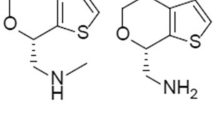Summary
The pharmacokinetics and relative bioavailability of fluoxetine capsules (reference) and tablets (test) were compared in 24 healthy subjects of both sexes after a single 20 mg oral dose of fluoxetine (as a hydrochloride salt).
A randomized, crossover design with a 2-week wash-out period between each dose was applied. Serum samples, obtained before dosing and at various appropriate time points up to 192 hours, were analyzed for fluoxetine and norfluoxetine content by a simple, accurate and precise HPLC method. ANOVA, power analysis, 90% confidence intervals (CI), and two one-sided tests were used for the statistical analysis of pharmacokinetic parameters.
The tolerability of the preparations was good. The respective point estimates of the ratios of the geometric means of log-Cmax and log-AUC0−∞ of fluoxetine were 0.912 and 0.935 with 90% of 0.838–0.992 and 0.857–1.020. The corresponding point estimates of norfluoxetine were 0.952 (90% CI=0.843−1.075) and 0.904 (90% CI=0.807−1.013), respectively.
Since both 90% CI for the AUC0−∞ and Cmax geometric mean ratios of fluoxetine and norfluoxetine were included in the 80% to 125% interval proposed by the FDA the test drug (fluoxetine tablets) was considered bioequivalent to the reference one (Prozac® capsules) according both to the rate and extent of absorption.
Similar content being viewed by others
References
Lemberger L., Bergestrom R.F., Wolen R.L., Farid N.A., Enas G.G., Aronoff G.R. (1985): Fluoxetine: clinical pharmacology and physiologic disposition. J. Clin. Psychiatry 46, 14–19.
Benfield P., Heel R.C., Lewis S.P. (1986): Fluoxetine: a review of its pharmacodynamic and pharmacokinetic properties, and therapeutic efficiency in depressive illness. Drugs, 32, 481–508.
Altamura A.C., Moro A.R., Percudani M. (1994): Clinical pharmacokinetics of fluoxetine. Clin. Pharmacokinet., 26, 201–204.
Aronofrf G.R., Bergstrom R.F., Pottratz S.T., Sloan R.S., Wolen R.L., Lemberger L. (1984): Fluoxetine kinetics and protein binding in normal and impaired renal function. Clin. Pharmacol. Ther., 36, 138–144.
Kristensen J.H., Ilett K.F., Hackett L.P., Yapp P., Paech M., Begg E.J. (1999): Distribution and excretion of fluoxetine and norfluoxetine in human milk. Br. J. Clin. Pharmacol., 48, 521–527.
Liu Z.Q., Cheng Z.N., Huang S.L., Chen X.P., Ou-Yang D.S., Jiang C.H., Zhou H.H. (2001): Effect of the CYP2C19 oxidation polymorphism on fluoxetine metabolism in Chinese healthy subjects. Br. J. Clin. Pharmacol. 52, 96–99.
Jannuzzi G., Gatti G., Magni P., Spina E., Pacifici R., Zuccaro P., Torta R., Guarneri L., Perucca E. (2002): Plasma concentrations of the enantiomers of fluoxetine and norfluoxetine: sources of variability and preliminary observations on relations with clinical response. Ther. Drug Monit. 24, 616–627.
Heikkinen T., Ekblad U., Palo P., Laine K. (2003): Pharmacokinetics of fluoxetine and norfluoxetine in pregnancy and lactation. Clin. Pharmacol. Ther. 73, 330–337.
Albrecht A., Adler R.H. (2001): Therapeutic inadequancy in spite of bioequivalency on replacing Flucitine® with Fluocim®. Swiss Med. Wkly. 131, 84.
The United States pharmacopoeia, 24th ed., Rockville, MD: United States Pharmacopoeial Convention, Inc., 2000, 1941–1943.
Guidance for industry, bioanalytical method validation (issued May 2001). Available at: http://www.fda.gov/cder/guidance/index.htm.
Schulz H.U., Steinijans V.W. (1991): Striving for standards in bioequivalence assessment: a review. Int. J. Clin. Pharmacol. Ther. Toxicol. 29, 293–298.
Zintzaras E. (2005): Statistical aspects of bioequivalence testing between two medicinal products. Eur. J. Drug Metab. Pharmacokinet., 30, 41–46.
Chow S.C., Liu J.P. Design and analysis of bioavailability and bioequivalence studies, 2nd ed., New York: Marcel Dekker, 2000, 57–78.
Guidance for Industry, Bioavailability and bioequivalence studies for orally administered drug products — general considerations (issued October 2000). Available at: http://www.fda.gov/cder/guidance/index.htm.
Hauck W.W., Parekh A., Lesko L.J., Chen M.L., Williams R.L. (2001): Limits of 80%–125% for AUC and 70%–143% for Cmax. What is the impact on bioequivalence studies? Int. J. Clin. Pharmacol. Ther. 39, 350–355.
Addison R.S., Franklin M.E., Hooper W.D. (1998): Sensitive, high-throughput gas chromatographic-mass spectrometric assay for fluoxetine and norfluoxetine in human plasma and its application to pharmacokinetic studies. J. Chromatogr. B. Biomed. Sci. Appl. 716, 153–160.
Moraes M.O., Lerner F.E., Corso G., Bezerra F.A., Moraes M.E., De Nucci G. (1999): Fluoxetine bioequivalence study: quantification of fluoxetine and norfluoxetine by liquid chromatography coupled to mass spectrometry. J. Clin. Pharmacol. 39, 1053–1061.
Sutherland F.C., Badenhorst D., de Jager A.D., Scanes T., Hundt H.K., Swart K.J., Hundt A.F. (2001): Sensitive liquid chromatographic-tandem mass spectrometric method for the determination of fluoxetine and its primary active metabolite norfluoxetine in human plasma. J. Chromatogr. A. 914, 45–51.
Li C., Ji Z., Nan F., Shao Q., Liu P., Dai J., Zhen J., Yuan H., Xu F., Cui J., Huang B., Zhang M., Yu C. (2002): Liquid chromatography/tandem mass spectrometry for the determination of fluoxetine and its main active metabolite norfluoxetine in human plasma with deuterated fluoxetine as internal standard. Rapid Commun. Mass Spectrom. 16, 1844–1850.
Herchuelz A. (1996): Bioequivalence assessment and the conduct of bioequivalence trials: a European point of view. Eur. J. Drug Metab. Pharmacokinet. 21, 149–152.
Patnaik, R., Lesko, L.J., Chan, K., Williams R.L. (1996): Bioequivalence assessment of generic drugs: an American point of view. Eur. J. Drug Metab. Pharmacokinet. 21, 159–164.
Pan, R.N., Chen, T.H., Shu-Hiu Huang, C., Hsiong C.H. (2002): Pharmacokinetics and bioequivalent study of generic fluoxetine capsules preparation. J. Food Drug Anal. 10, 13–17.
Guidance for industry, statistical approaches to establishing bioequivalence (issued January 2001 ). Available at: http://www.fda.gov/cder/guidance/ index.htm.
Author information
Authors and Affiliations
Rights and permissions
About this article
Cite this article
Jovanović, D., Kilibarda, V., Dordević, S. et al. Bioequivalence testing of a new tablet formulation of generic fluoxetine. European Journal of Drug Metabolism and Pharmacokinetics 31, 35–40 (2006). https://doi.org/10.1007/BF03190640
Received:
Issue Date:
DOI: https://doi.org/10.1007/BF03190640




